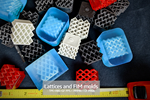AddiFab, the inventor of Freeform Injection Molding (FIM) which creates a hybrid of additive manufacturing and standard molding via printed tools that can mold existing materials in standard machines, has new capital and a new headquarters. An investment round led by private equity firm West Hill Capital took 48 hours, was oversubscribed and generated $6.3 million.

Addifab’s new headquarters in Taastrup has more than twice the space of its former site in Jyllinge and moves it closer to Copenhagen.
To meet increased demand for FIM, AddiFab required a larger facility. Located near the Copenhagen airport, the new headquarters will offer more than twice the space for growth than its old operation in Jyllinge, Denmark. A company spokesperson told Plastics Technology that the new site covers nearly 34,000-ft2 and will be home to 80 to 100 employees.
Lasse Staal, CEO and co-founder of AddiFab, said in a release that the new facility will give his company greater capability to undertake feasibility studies, on-site R&D projects and deliver larger FIM systems, with a goal of tripling the number of systems that can be produced, while also “dramatically” increasing the number of customer evaluation projects that can be carried out. In addition to production and assembly space, the new headquarters will be home to R&D, sales, demonstration platforms and labs.
Staal said the new funding will strengthen global availability of FIM, which was boosted in 2019 by the company’s agreement with Mitsubishi Chemical Advanced Materials for that company to add FIM as a service in the U.S., E.U. and Japan.
Related Content
-
Additive Technologies for Injection Mold Tooling Ride Tailwinds
NPE2024: Lowering barriers to additive manufacturing adoption in toolmaking.
-
Production Tool, Prototype Time
Mantle's metal 3D printing technology targeted toolmaking and injection molders and moldmakers are taking notice.
-
The Connector Conundrum: 3D Printed Mold Tooling’s Role in Innovation
ReelView Fishing faced an electronics obstacle in the development of its new technology for underwater video. Additive manufacturing for moldmaking allowed for the speed necessary to iterate to a solution. How inventors and invention will benefit from new ways of obtaining production-ready tooling.













